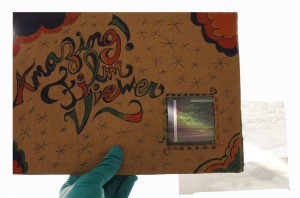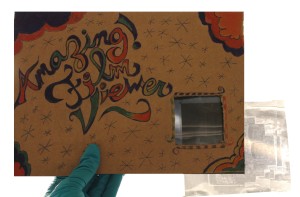Story
The Amazing Film Viewer
Demystifying Negative Preservation One Rainbow at a Time
I have just finished rehousing and processing all of the photographic prints in the David DeHarport Collection! Hold your applause though; I still need to process approximately 2000 color slides, 6200 large format negatives, and 3000 35mm negatives. However, before I begin to wrangle with the organization of the DeHarport negatives, I must consider their long-term preservation.
Photographic film confronts the archivist with some hairy preservation challenges. As certain types of negatives age, they can disintegrate, emanate noxious fumes and gases, or even explode (in the case of nitrate motion picture film). Sound scary? Don’t freak out just yet! Ultimate destruction and stinkiness is not necessarily the fate of all photographic negatives; a negative’s film base, as well as its storage conditions, greatly impact its rate of deterioration. Luckily for me, the infamous and (somewhat) combustible cellulose nitrate film negative is absent from the DeHarport Collection. This leaves cellulose acetate and polyester film bases. While polyester negatives are generally stable, acetate negatives off gas acetic acid as they deteriorate. This type of degradation, often called Vinegar Syndrome, can have an insidious effect not only on the negatives themselves, but also on other material in the collection. Plus, it can be difficult to distinguish the two types of film; they share common use dates and can both be marked “Safety Film.”

Polyester negatives create rainbow-like patterns when viewed between the two polarizing filters in the window of the AMAZING FILM VIEWER
Luckily, I can use AMAZING FILM VIEWER to identify acetate and polyester films. When positioned in the window of the Viewer, polyester negatives produce rainbow-like interference colors (think the colors produced by an oil slick). Acetate negatives, however, leave the window dark. Thanks to this tool, I can figure out which negatives need to be housed separately from other materials and eventually placed in a special preservation environment. Have some negatives of your own that you want to preserve? You can make your own AMAZING FILM VIEWER! All you need is two pieces of mat board and two polarizing filters. Please note: decorating the Viewer is optional, but highly useful in making sure the Viewer isn’t accidently thrown away. Check out these instructions from National Park Service’s Museum Management Program for more information!


